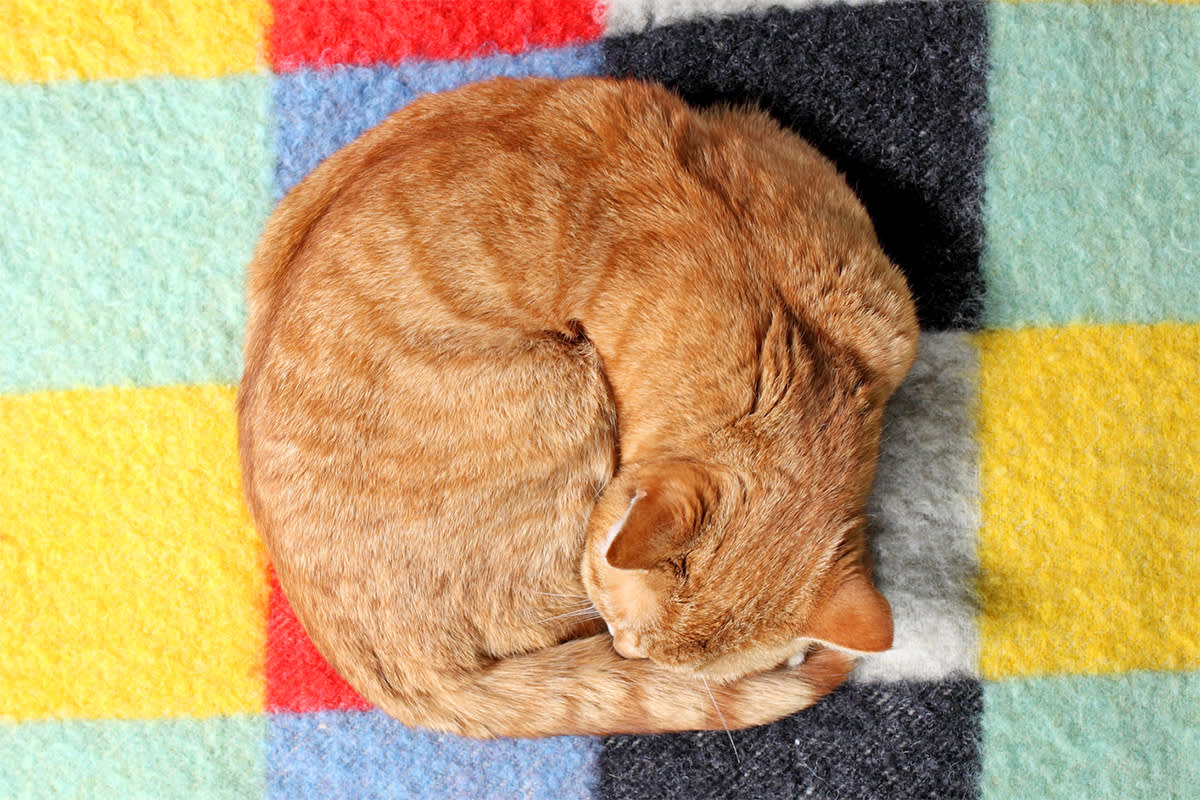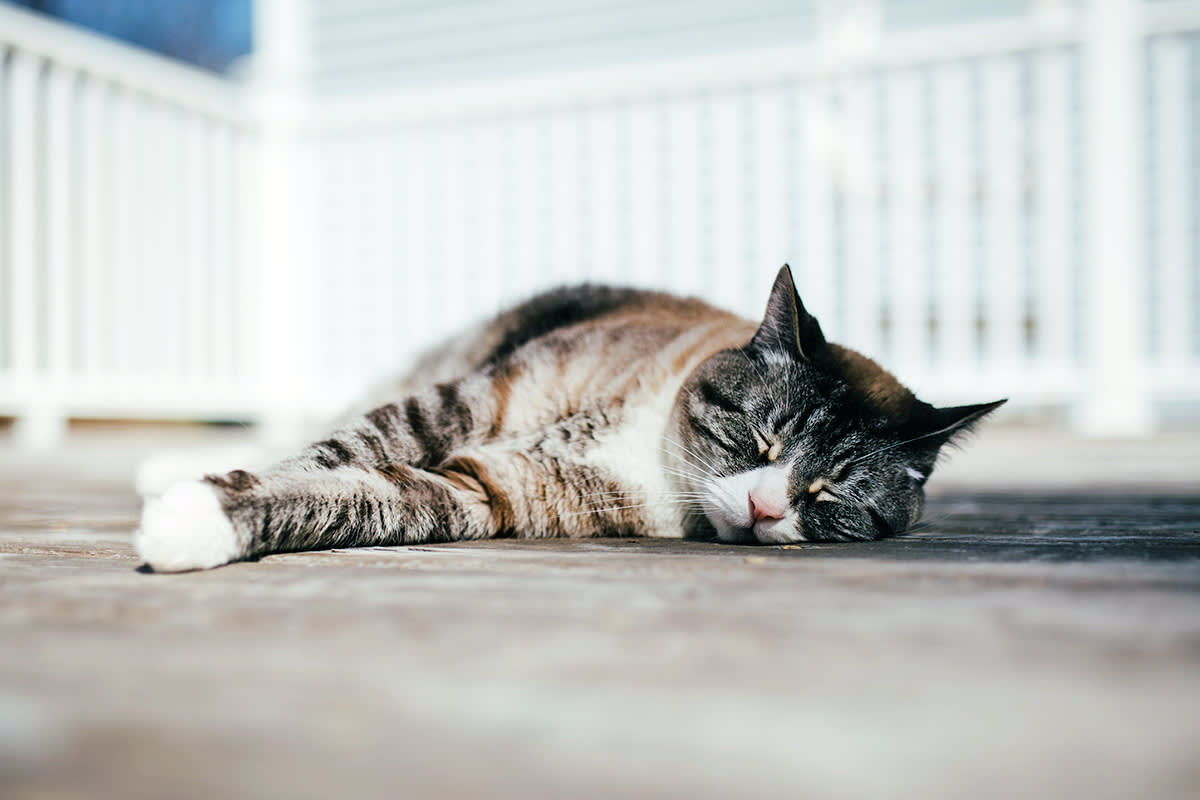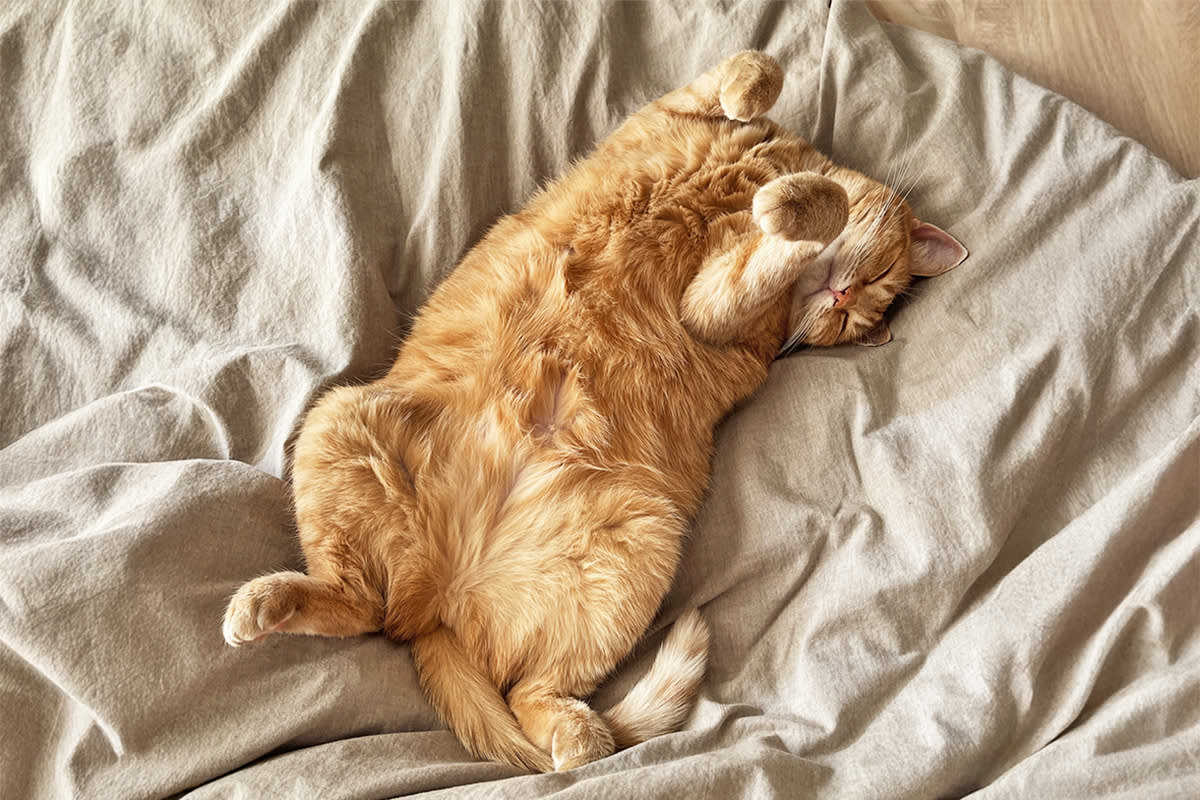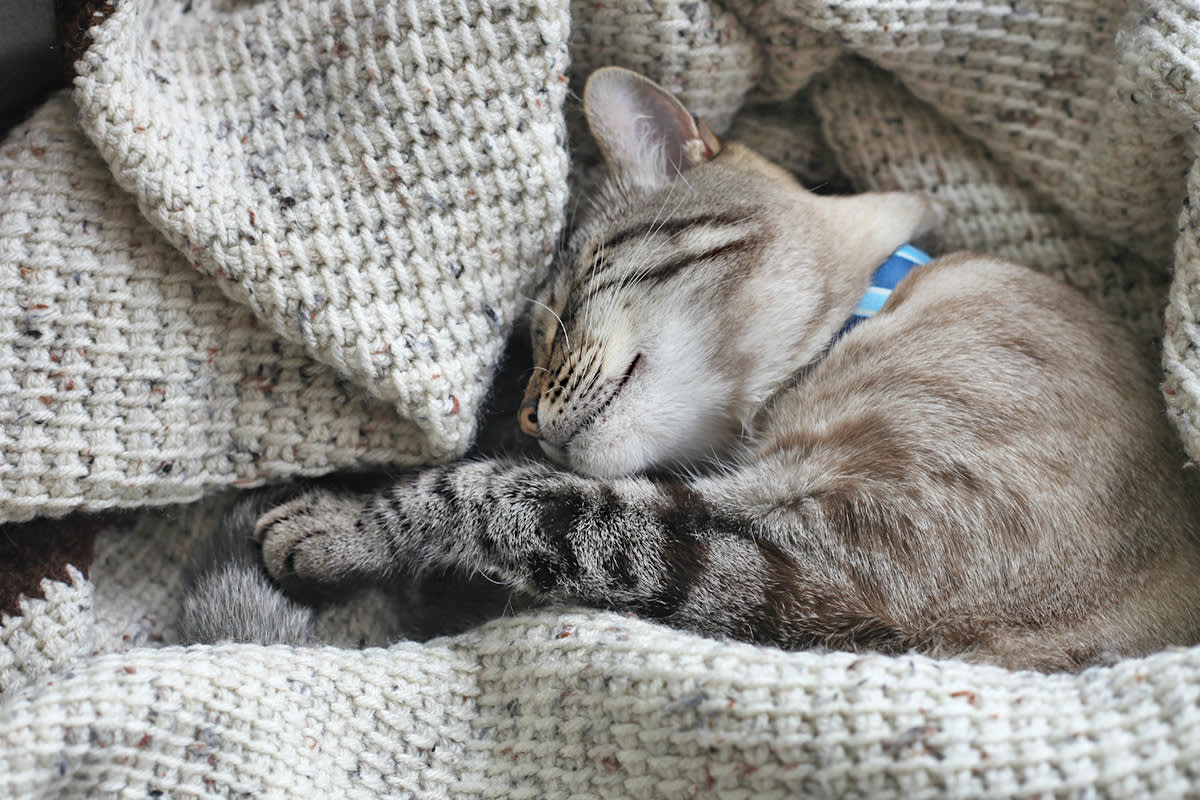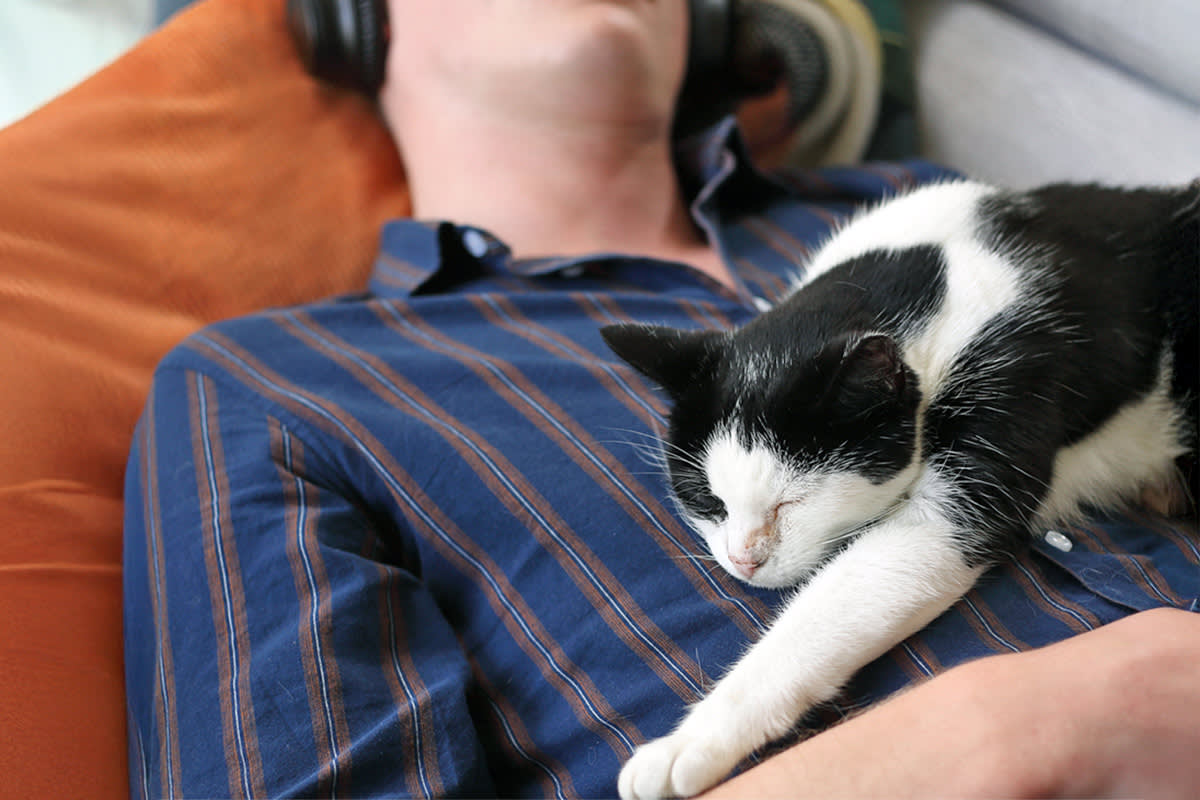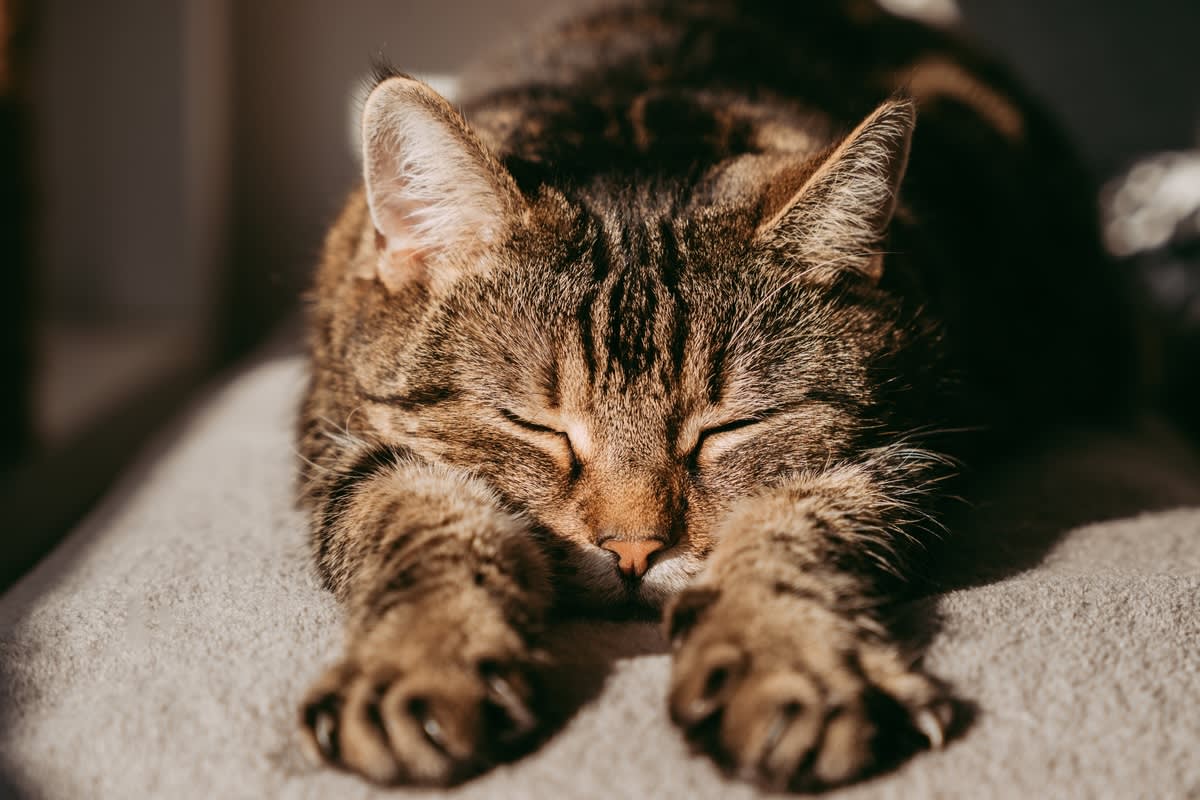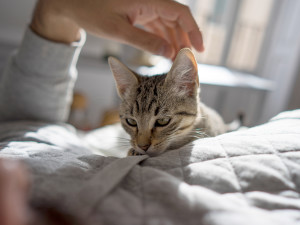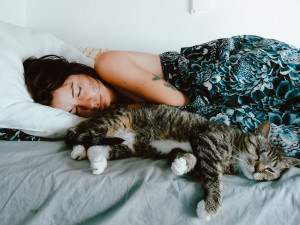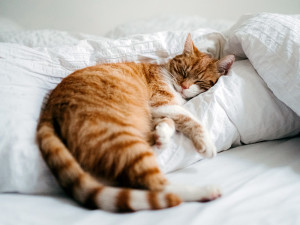What Does Your Cat’s Sleeping Position Say About Them?
Is your cat a croissant? A splooter? A cuddler?

Share Article
Cats are famously expert sleepers — so much so that we’ve named a nap after them. They spend more than half their days snoozing. As cat parents, we may frequently regard our slumbering companions and wonder things like: What do they dream about? Is it possible to trade lives with a cat? How can I get my cats to pitch in on my rent?
While animal behaviorists haven’t been able to answer those questions (or at least definitively), there is some useful information we can glean from your sleeping kitty. The position your cat sleeps in can tell you a lot about their level of comfort and how secure they feel in your home, and in some cases it can even reveal information about their relationship to you and to each other.
Certified cat behaviorists Rita Reimers and Linda Hall of Cat Behavior Allianceopens in new tab took us through several of the most common catnap positions to tell us what they mean — and when you might need to call a vet.
Croissant
Sometimes called “the crescent” or “shrimp,” this position refers to when your cat curls up in a neat little ball, nose-to-tail. Per Hall and Reimers, this sleep shape serves several purposes. First, it helps conserve their body heat, keeping them warm and cozy while they nap. But it’s also a behavioral adaptation left over from their time as a wild species. “In nature, [cats] try to make themselves as small as possible, so predators don’t see them,” Reimers says. By sleeping this way, a crescent-shaped napper is instinctively protecting their belly and vital internal organs from threats.

But don’t fret that your curled-up cat is feeling insecure or at-risk. Hall points out that “it would be hard to get out of that position and run,” so a curled-up cat is still feeling pretty confident that they’re safe.
Loaf
Possibly the most iconic of all cat poses, with the cat’s belly on the floor and their paws curled neatly underneath, the loaf position shows a cat who’s primed to bolt. Cats are both predator and prey in the wild, so even at rest they often need to be ready to either flee or pounce, and the loaf position is one that they can get up from very quickly if necessary.
But don’t take it personally if your cat sleeps this way. “Some cats are just naturally more anxious than others,“ Hall says. “Maybe they’ve got some past stuff going on… it’s not necessarily a reflection on you.” Cats may also doze off this way when they know they’ve got food coming soon, simply so they can dash for their bowls as quickly as possible.
Side sleeping
A side-sleeping cat is a relaxed and happy cat, and it’s common to find them luxuriating like this on your floor in a nice patch of sunlight. “Side sleeping is a vulnerable position,” Hall says. “That cat is very secure and comfortable … you have made them feel safe.” When they lay on the floor, it can help with their body’s temperature regulation. Cats may assume this position to bask in sunlight during colder seasons or to spread out on cool surfaces like tile or cement in warmer weather.
Belly-up
A cat who likes to sleep on their back is displaying the ultimate level of comfort, because not only are all of their internal organs exposed and unprotected, it’s a difficult position for them to get up and run from. “It’s a sign of trust,�” Reimers says. So, if your cat likes to doze off belly-up, take it for the compliment that it is —but try not to take the bait and rub their tummies, as most cats sadly don’t enjoy a good belly rub.
Burrowing
A cat who likes to sleep burrowed under a blanket may just be trying to keep warm. In terms of their comfort level and feelings of vulnerability, Hall and Reimers say this is one of the few sleeping positions that could go either way. “Some cats are just burrowers,” Hall says. “In nature, they’re looking for bushes, porches, places that they can hide and hunker down, to protect them from the elements and neighborhood dogs or whoever's going to hurt them.”
In some cases, burrowing can be a response to stress or fear, like in the case of being exposed to a new person or animal in the house. “But if they’re under the covers with you, it’s because they feel secure,” Reimers says.
Co-sleeping with you
Obviously, a cat who wants to sleep on top of or close to you does so because they feel bonded to you and they’re showing affection. Plus, you can mutually benefit from each others’ body heat. But did you know that in a house with multiple cats, their position on your body may also reflect their hierarchy? The dominant cat is going to want to sleep “as high up on you as possible,” Reimers adds. “If they lay on your head, they’re trying to say, ‘This is mine. Top position.’”
Your smell also plays a role in where they most like to cuddle — armpits, groin, and feet are all popular cuddle spots for a bonded cat. “It doesn’t mean you stink,” Reimers says. “It just means they can smell you.”
“We had a client once who was really skirting around trying to say, ‘Why does this cat want to sleep on my junk, in between my legs?’” Hall adds. “Cats love our odor. It makes them feel comfortable.”
Planking/splooting
Sometimes, a cat will nap on their belly, with their front paws stretched out ahead of them and their back legs stretched out behind. “That stretch means that they're not feeling vulnerable,” Hall says. “They’re not gonna have to jump up real quick. They’re sprawled out.”
When to worry
All of the sleeping positions above are within the realm of normal behavior for a healthy domestic cat. But sometimes, how a cat sleeps can be a sign that something’s not right. Head pressing — when a cat falls asleep sitting still with their head pressed against a wall or piece of furniture — is a definite cause for concern, as it’s usually a sign of the neurological condition hepatic encephalopathyopens in new tab. Falling asleep in the litter box may also merit a trip to the vet, especially if it happens frequently, as it could indicate gastrointestinal problems or a urinary tract infection (UTI). A cat sleeping by their water or food bowl is something to look out for, too, as it could be an indicator of diabetes or a thyroid issue.
Generally, Hall and Reimers also advise cat parents to pay attention when they notice a significant deviation from their cat’s normal behavior; a sudden shift in their usual habits may be worth a call to the vet. For example, a cat who’s usually not very affectionate suddenly clinging to you, or a cat who’s normally very social tucking themselves away. “In order to survive in nature, [cats] mask their illness,” Reimers says. “They’ll hide away rather than show you they’re sick. And by the time you notice it, sometimes it’s serious.”

Rachel Pick
Rachel Pick is a freelance writer and social media editor who has written for Vice, The Guardian, and SELF. She lives with two cats: Cricket, a genteel lady who is the picture of refinement, modesty, and good manners; and Cowboy, who is an agent of chaos, slapstick comedy, and foul odors. Her work here frequently focuses on cat companionship and cat behavior.
Related articles
![kitten sleeping on top of person]()
Why Does Your Cat Sleep on You? 7 Reasons and What It Means
Not into cuddling? Too bad—they’re spending the night.
![woman with dark hair lying in bed with striped cat, both asleep]()
Should I Let My Cat Sleep With Me? Things to Consider About Having Your Cat in Bed
Here are the pros and cons of having a feline sleeping buddy.
![a red cat stretching on a bed]()
Why Is My Cat Twitching in Their Sleep?
Sure, it’s curious—but is it also concerning?
Why Does My Cat Sleep at My Feet?
Other than the fact that they love you so very much.
Why Does My Cat Watch Me Sleep?
Is it creepy or sweet? With help from an expert, we got to the bottom of why they’re staring at you.
![orange cat sleeping on pillow]()
Can Cats Have Nightmares?
If so, they’re probably about going to the vet in that stupid carrier.
![Curled up tabby cat sleeping on pillows]()
Why Do Cats Sleep So Much?
A very sleepy kitty isn’t usually a problem, but watch out for these signs of medical distress.

